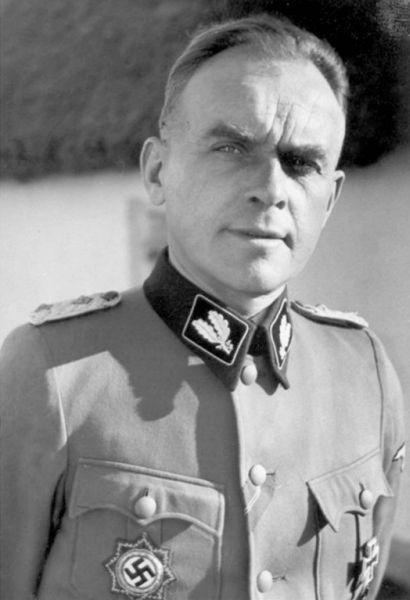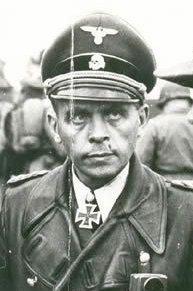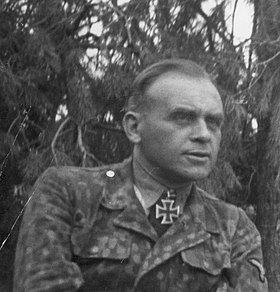Wagner, Jürgen (SS-Pz.Gren.Reg. 9 "Germania")
- Date of birth:
- September 9th, 1901 (Strasbourg-Neudorf/Alsace, Germany)
- Date of death:
- June 27th, 1947 (Belgrade, Yougoslavia)
- Buried on:
- German War Cemetery Belgrade
- Service number:
- SS-Nr.: 23.692 // NSDAP-Nr.: 707.279
- Nationality:
- German
Biography
SS-Brigadeführer Jürgen Adolph Otto Paul Wagner
Promotions:
00.00.1921: Junker
00.00.1925: Fahnenjunker-Unteroffizier
15.06.1931: SS-Mann
00.10.1931: SS-Scharführer
15.02.1932: SS-Oberscharführer
02.04.1932: SS-Truppführer
20.04.1933: SS-Sturmführer
01.10.1933: SS-Sturmbannführer
04.07.1937: SS-Obersturmbannführer
01.09.1941: SS-Standartenführer
09.11.1942: SS-Oberführer
20.04.1944: SS-Brigadeführer und Generalmajor der Waffen-SS
Career:
00.00.1915: Kadettenanstalt Naumburg/Saale
00.00.1917: transferred to the Hauptkadettenanstalt Berlin-Lichterfelde
00.00.1920: Akademische Wehr Münster
00.03.1921: entered the Infanterie-Regiment 21 - Reichswehr
00.00.1924: Fahnenjunker - Reichswehr
01.06.1926: left the Reichswehr
15.06.1931: joined the SS
01.11.1931: joined the NSDAP
00.10.1932: Chef - SS-Sportschule Kalvoerde - Altmark
00.00.1933: F. SS-Sturm 3/IV/21 / 21. SS-Standarte - Magdeburg
09.07.1933: 3./ SS-Sonderkommando 'Jüterborg' - precursor of the Leibstandarte Adolf Hitler - Truppenübungsplatz Jüterbog
07.10.1933-29.06.1939: Kdr, II./ "LSSAH" - its first commander succeeded by Sbf Karl Reichsritter von Oberkamp
Campaigns in Austria, Sudetes and Poland with II./ 'LAH'
29.06.1939-01.11.1939: SS-Führer / Stab/ SS-Standarte "Deutschland" - SS-Div. "Reich"
01.11.1939-13.07.1941: Kdr., II./ SS-Standarte "Deutschland" - SS-Div. "Reich"
08.07.1941-01.09.1941: Kdr., SS-Regiment "Der Führer" - SS-Divison "Reich"
01.09.1941-00.00.1941: Kdr., SS-Infanterie Regiment 11 - SS-Divison "Reich"
22.11.1941: severely WIA in front of Moscow
00.02.1942: Kdr, Aufstellungsstab / "LSSAH"
15.07.1942-00.10.1943: Kdr., SS-Rgt. "Germania", 5. SS-Division 'Wiking'
Campaign in the Kaukasus region
00.10.1943-00.04.1944: Kdr., 4. SS-Freiwilligen-Panzergrenadier-Brigade "Nederland" - Croatia
00.12.1943: sent to the Leningrad-Front
00.04.1944-00.08.1944: Kdr., 4. SS-Polizei-Division
00.08.1944: Kdr., Kampfgruppe 'Wagner' - against the Tartu Offensive of the Soviet 3rd Baltic Front
10.02.1945: Kdr., 23. SS-Freiwilligen-Panzergrenadier-Division "Nederland", fightings around Stettin, Schwedt an der Oder then south of Berlin
05-06.05.1945: surrendered to the US troops at Tangenmünde
00.02.1947: extraded to Yugoslavia by the Brits
29.05.1947-06.06.1947: put on trial before the military tribunal of the 3rd Yugoslav Army in Zrenjanin
It is not precisely known for what he was indicted. However, his orders for the mass executions of civilians in 1941 and later on, reportedly played a role in his conviction.
27.06.1947: found guilty of the charges and sentenced to death by firing squad and executed
Do you have more information about this person? Inform us!
- Period:
- Second World War (1939-1945)
- Rank:
- SS-Obersturmbannführer (Lieutenant-colonel)
- Awarded on:
- May 16th, 1940
- Period:
- Second World War (1939-1945)
- Rank:
- SS-Obersturmbannführer (Lieutenant-colonel)
- Awarded on:
- July 1st, 1940
- Period:
- Second World War (1939-1945)
- Rank:
- SS-Standartenführer (Colonel)
- Awarded on:
- March 31st, 1941
- Period:
- Second World War (1939-1945)
- Rank:
- SS-Standartenführer (Colonel)
- Unit:
- Kdr, SS-Infanterie-Regiment "Deutschland", SS-Division (mot) Wiking
- Awarded on:
- November 22nd, 1941
- Period:
- Second World War (1939-1945)
- Rank:
- SS-Oberführer (Brigade General)
- Awarded on:
- August 1942
- Period:
- Second World War (1939-1945)
- Rank:
- SS-Standartenführer (Colonel)
- Unit:
- Kdr, SS-Infanterie-Regiment "Germania", SS-Division (mot) "Wiking"
- Awarded on:
- December 8th, 1942
Award 248/8.
- Period:
- Second World War (1939-1945)
- Awarded on:
- 1943
- Period:
- Second World War (1939-1945)
- Rank:
- SS-Oberführer (Brigade General)
- Unit:
- Kommandeur, SS-Panzergrenadier-Regiment 9 "Germania", SS-Panzer-Grenadier-Division „Wiking“, 1. Panzer-Armee, Heeresgruppe Süd
- Awarded on:
- July 24th, 1943
“Starting on the 16.07.1943 the enemy began a series of powerful attacks across the Donez river in the area west of Izyum with very strong forces that included numerous tanks. In response SS-Oberführer Wagner and his reinforced Regiment Germania were dispatched to the thick of the fighting, and were employed as a counterattacking force against broken-in enemy forces on the 17. & 18.07.1943 and then for defense against major hostile attacks on the 19.07.1943.
During the course of its counterattack the Regiment captured the extremely important villages of Ssawodskoj and Ssrednij on the 18.07.1943, and on the 19.07.1943 it repulsed attacks by the 20th Guards Rifle Division and two tank brigades. The swift capture of Ssawodskoj and Ssrednij prevented an enemy breakthrough attempt that could’ve potentially resulted in disastrous consequences for the entire frontline south of Izyum. This victory also prevented the enemy from sending in additional strong forces across the Donez.
On the 19.07.1943 the enemy penetrated friendly lines north of Andrejewka with two tank brigades and strong infantry forces, and then they continued thrusting southeastwards towards Andrejewka itself. SS-Oberführer Wagner perceived that this enemy battlegroup sought to achieve a deep breakthrough (this was eventually confirmed by prisoner statements), and so he decided to employ his II./SS-Pz.Gren.Rgt. Germania for an immediate counterthrust in spite of the fact that it had already been ordered to eliminate a penetration near Ssawodskoj.
During the heavy combat which followed SS-Oberführer Wagner was the soul of the fight. His energy and readiness for duty in the midst of the most ferocious fighting enabled him to smash far numerically superior hostile forces with relatively weak units of his own. 35-40 enemy tanks were also destroyed in the process. With this the enemy was thwarted in their efforts to achieve a breakthrough, and the original frontline was eventually brought firmly under friendly control.”
1896th Award.
- Period:
- Second World War (1939-1945)
- Rank:
- SS-Brigadeführer / Generalmajor der Waffen-SS (Brigadier)
- Unit:
- Kommandeur, 4. SS-Freiwilligen Panzergrenadier-Brigade "Nederland", III.(germanische) Panzer-Korps, Heeresgruppe Nord
- Awarded on:
- December 11th, 1944
“Since being awarded the Knight’s Cross to the Iron Cross on the 20.07.1943 [sic] SS-Brigadeführer Wagner has repeatedly distinguished himself while serving as commander of the 4. SS-Freiw.Pz.Gren.Brig. Nederland.
Following a difficult series of withdrawals from the Oranienbaum Front the young Brigade was assigned the task of assisting the defense of the friendly bridgehead at Narva. Clearly recognizing that the focus of the future defensive combat would be around Lilienbach, Wagner tirelessly endeavoured to plan and supervise the undertaking of all necessary defensive measures in the area. Despite major enemy attempts at harassing fire he was repeatedly able to determine the direction of the main hostile axis of advance. The enemy began their major assault on the 08.03.1944 following 10-11 nights that each saw 2 airstrikes conducted by strong enemy bomber formations. However although this attack was executed with overwhelming infantry forces along with tank support it was nonetheless successfully repulsed.
Yet the enemy continued their attacks, and up until the end of March they continued to try to roll up the Narva bridgehead despite sustaining high losses in men and materiel. Throughout this time the personality of Brigadeführer Wagner was the soul of the defense. From his command post (located just 800 metres behind the frontline) he continuously involved himself in the thick of the action, and through this personal example he inspired his officers, NCOs and men to achieve the highest standard of resistance. The result was that the attackers were unable to roll up the bridgehead and thereby compromise the whole Narva front.
Later, on the 12. & 13.08.1944, the enemy managed to thrust through the frontline of 18. Armee in the area west of Lake Peipus and thereby endanger both Tartu and the southern flank of Armer-Abteilung Narva. In response a blocking formation consisting of various units was placed under command of SS-Brigadeführer Wagner and assembled in the Dorpat area on the 14. & 15.08.1944.
At 04:15 on the 16.08.1944 enemy forces launched a surprise strike over the strait connecting the two parts of Lake Peipus with strong forces. They managed to successfully cross at Mehikoorma before advancing towards Tartu. Wagner thus launched an immediate counterattack against them with all available forces. This pushed the enemy back towards the east and permitted the 207. Sicherungs-Division to disengage from the enemy (its retreat roads had previously been blocked by hostile forces).
In the subsequent days the enemy continued pressing their attacks against Tartu from the east, southeast and south. However thanks to the devotion to duty and flexible leadership displayed by Wagner it was possible to inflict high losses on the oncoming Soviet troops, with the result that their offensive power decreased with each passing day. His actions furthermore laid the groundwork for the timely intervention by the newly arrived 87. Infanterie-Division, and with its help the enemy offensive was brought to a definitive halt along the Emajõgi river.
While the III. (germ.) SS-Panzer-Korps was pulling out of Estonia the enemy’s strong forces were able to achieve a breakthrough in the sector of L. Korps (specifically northwest of Wolmar), and whilst exploiting this success they occupied the city of Wolmar with significant armoured forces.
In response, on the 23.09.1944, the 4. SS-Freiw.Pz.Gren.Brig. Nederland was temporarily removed from the III. (germ.) SS-Panzer-Korps and assigned to L. Korps. On the evening of the same day it was sent to the area northwest of Wolmar in order to seal off the hostile breakthrough. In 3 days of fierce combat Brigadeführer Wagner and his Brigade were able to repulse powerful enemy attacks whilst inflicting high losses in men and materiel. All crises in this sector were overcome, and this permitted the execution of an orderly withdrawal by both L. and II. Korps (the latter of which was positioned further to the north).
Later, after it had completed operations around Doblen, the 4. SS-Freiw.Pz.Gren.Brig. Nederland reassembled in the area southwest of Grobin. From here it received orders on the night of the 13./14.10.1944 to advance to the Barta area in order to support the 11. Infanterie-Division. Specifically, it was to assist in the operations to close the frontline gap north of the Tirs-Purvs swamp and to eliminate those enemy forces that had advanced into the wooded terrain north of the swamp. This latter enemy force (consisting of about 2 regiments with heavy weapon support) had advanced through a frontline gap in the sector of Grenadier-Regiment 23 and infiltrated into an almost impassable patch of forest. Weak friendly forces secured the eastern edge of this forest, whilst swiftly assembled artillery alarm units were deployed in the north. The danger was that the enemy would reinforce their forces with tanks and infantry before overrunning our weak lines and ultimately breaking through in the direction of Libau.
In this critical predicament SS-Brigadeführer Wagner decided to split up his Brigade into 4 assault wedges and attack this enemy-occupied forest. The aim was to eliminate this hostile grouping whilst simultaneously closing the frontline gap. The Brigade became embroiled in difficult forest combat that was sometimes conducted at night, however after 3 days it had managed to clear the forest. The bulk of the enemy troops that had entered the forest did not escape, and significant quantities of materiel were also captured.
This success is attributable to both the bravery of the troops and the prudent, flexible leadership of Brigadeführer Wagner. In every critical moment he was the master of the situation, and he never shied away from giving all he had to his mission.
The ultimate outcome was that the enemy was prevented from achieving a breakthrough towards Libau.”
680th Award.
- Period:
- Second World War (1939-1945)
Sources
- Photo 1: Peter van Holsteijn
- - MOONEY, PETER, Waffen-SS Knights and their Battles, Schiffer Publishing, Ltd, 2010.
- THOMAS, FRANZ & WEGMANN, GüNTER, Die Eichenlaubträger 1940-1945, Biblio-Verlag, 1998.
- Die Ordensträger der Deutschen Wehrmacht (CD), VMD-Verlag GmbH, Osnabrück, 2002
- Kwasny A., Kwasny G., Die Eichenlaubträger 1940-1945 (CD), Deutsches Wehrkundearchiv, Lage-Waddenhausen, 2001
- Fellgiebel W.P., Elite of the Third Reich, The recipients of the Knight's Cross of the Iron Cross 1939-1945: A Reference, Helion & Company Limited, Solihull, 2003, ISBN 1-874622-46-9
- Patzwall K., Scherzer V., Das Deutsche Kreuz 1941-1945, Geschichte und Inhaber Band II, Verlag Klaus D. Patzwall, Norderstedt, 2001
- Twentsch Nieuwsblad, Friday 29th December 1944
- Detailansicht
- Microfilm Publication A3343. US National Archives
























